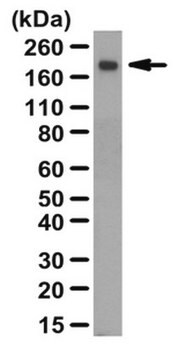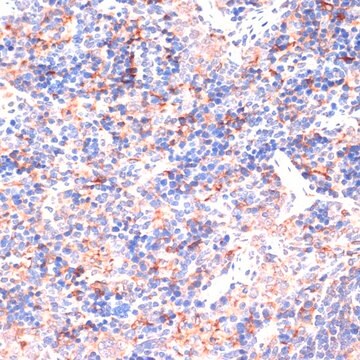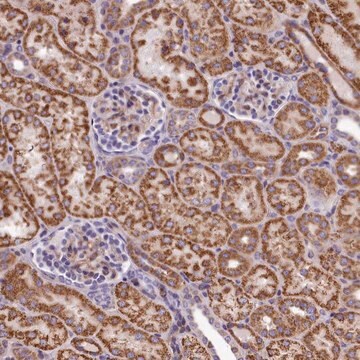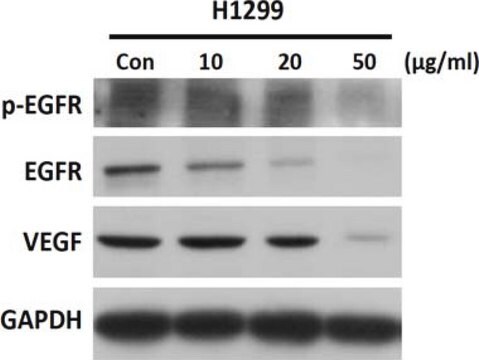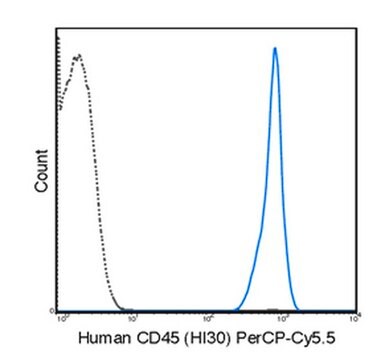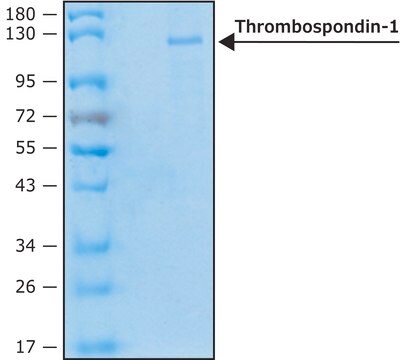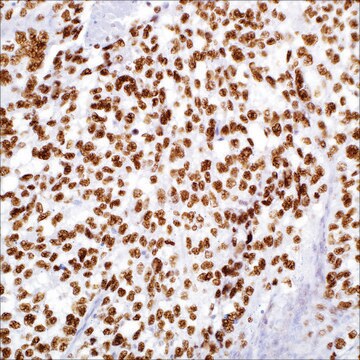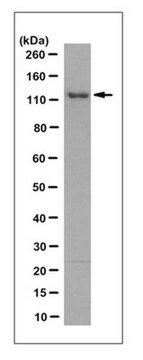MABT879
Anti-Thrombospondin-1 Antibody, clone 133
clone 133, from mouse
Synonyme(s) :
Thrombospondin-1, THBS-1, TSP-1
About This Item
Produits recommandés
Source biologique
mouse
Niveau de qualité
Forme d'anticorps
purified immunoglobulin
Type de produit anticorps
primary antibodies
Clone
133, monoclonal
Espèces réactives
rat, human
Technique(s)
ELISA: suitable
immunohistochemistry: suitable (paraffin)
neutralization: suitable
western blot: suitable
Isotype
IgG2bκ
Numéro d'accès NCBI
Numéro d'accès UniProt
Conditions d'expédition
dry ice
Modification post-traductionnelle de la cible
unmodified
Informations sur le gène
human ... THBS1(7057)
Description générale
Spécificité
Immunogène
Application
Cell Structure
ECM Proteins
Western Blotting Analysis: A representativev lot ditected full-length human thrombospondin-1 (hTSP-1) as well as hTSP-1 C-terminal fragments E3CaG (a.a. 648-1170), E3Ca (a.a. 648-945) and Ca (a.a. 692-945), but not hTSP-2, mouse TSP-1 (mTSP-1), or mTSP-2 by Western blotting under either reducing or non-reducing condition (Annis, D.S., et al. (2006). J. Thromb. Haemost. 4(2):459-468).
Western Blotting Analysis: A representative lot detected an upregulated thrombospondin-1 (TSP-1) in human pancreatic cancer Panc-1 cells upon siRNA-mediatted k-Ras knockdown (Fleming, J.B., et al. (2005). Mol. Cancer Res. 3(7):413-423).
Immunohistochemistry Analysis: A representative lot detected elevated thrombospondin-1 (TSP-1) immunoreactivity in vascular tissues surrounding stent materials due to in-stent restenosis (ISR) in paraffin-embedded sections of human coronary arteries from patients received either Taxus or Cypher drug-eluting stent implant (Pallero, M.A., et al. (2010). J. Vasc. Res. 47(4):309-322).
Neutralizing Analysis: Representative lots prevented alkaline-stripped human platelet thrombospondin-1 (sTSP-1) from activatating the latent form of TGF-beta secreted by cultured NMuMG murine mammary gland epithelial cells or bovine aortic endothelial (BAE) cells without affecting cellular signaling induced by the mature/active form of TGF-beta (Alcaraz, L.B., et al. (2014). J. Cell Biol. 205(3):409-428; Annis, D.S., et al. (2006). J. Thromb. Haemost. 4(2):459-468; Schultz-Cherry, S., and Murphy-Ullrich J.E. (1993). J. Cell Biol. 122(4):923-932).
Neutralizing Analysis: A representative lot inhibited stainless steel (SS) ions-induced TGF-β signaling in cultured primary rat vascular smooth muscle cells (VSMCs) as indicated by a suppressed induction of the synthetic/myofibroblastic protein ED-A FN (Pallero, M.A., et al. (2010). J. Vasc. Res. 47(4):309-322).
ELISA Analysis: A representativev lot ditected full-length human thrombospondin-1 (hTSP-1) as well as hTSP-1 C-terminal fragments E3CaG (a.a. 648-1170) and E3Ca (a.a. 648-945), but not hTSP-2, mouse TSP-1 (mTSP-1), or mTSP-2 by direct/non-sandwich ELISA (Annis, D.S., et al. (2006). J. Thromb. Haemost. 4(2):459-468).
Qualité
Western Blotting Analysis: 0.1 µg/mL of this antibody detected Thrombospondin-1 in 0.1 µg of human thrombospondin-1 purified protein.
Description de la cible
Forme physique
Stockage et stabilité
Handling Recommendations: Upon receipt and prior to removing the cap, centrifuge the vial and gently mix the solution. Aliquot into microcentrifuge tubes and store at -20°C. Avoid repeated freeze/thaw cycles, which may damage IgG and affect product performance.
Autres remarques
Clause de non-responsabilité
Vous ne trouvez pas le bon produit ?
Essayez notre Outil de sélection de produits.
Code de la classe de stockage
12 - Non Combustible Liquids
Classe de danger pour l'eau (WGK)
WGK 2
Point d'éclair (°F)
Not applicable
Point d'éclair (°C)
Not applicable
Certificats d'analyse (COA)
Recherchez un Certificats d'analyse (COA) en saisissant le numéro de lot du produit. Les numéros de lot figurent sur l'étiquette du produit après les mots "Lot" ou "Batch".
Déjà en possession de ce produit ?
Retrouvez la documentation relative aux produits que vous avez récemment achetés dans la Bibliothèque de documents.
Notre équipe de scientifiques dispose d'une expérience dans tous les secteurs de la recherche, notamment en sciences de la vie, science des matériaux, synthèse chimique, chromatographie, analyse et dans de nombreux autres domaines..
Contacter notre Service technique